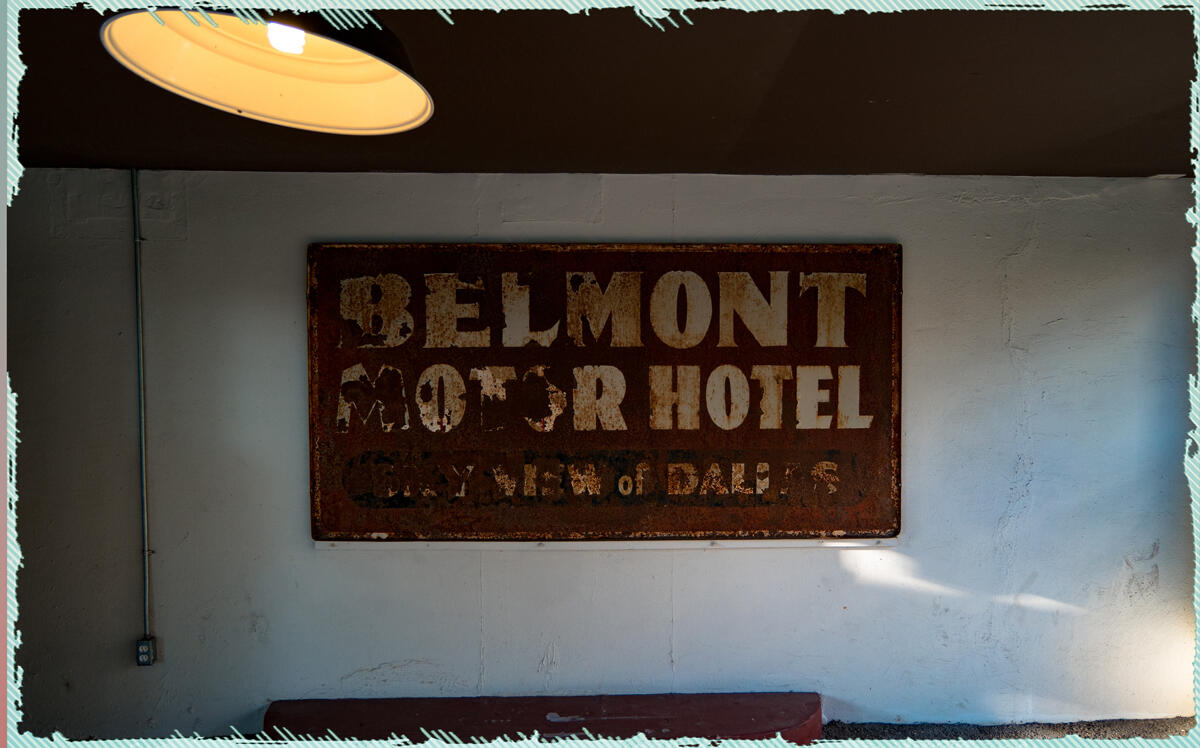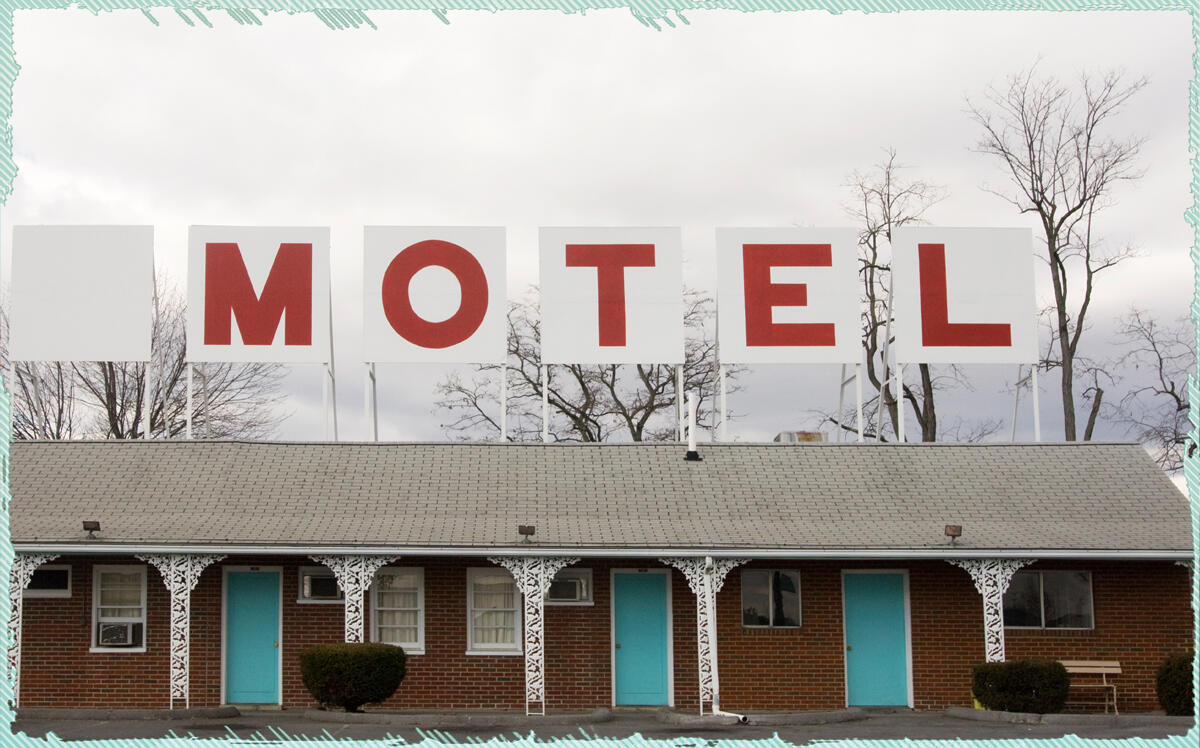Monte Anderson says there are at least two ghosts at the Belmont Hotel in Dallas, but plenty else haunts the old motor inn these days.
The Belmont looks like the Texan offspring of a tryst between a California bungalow and a Spanish villa. Wrought-iron curlicues adorn the balconies of the hotel’s freestanding, one-story lodges, whose pops of orange and blue and red break up their white stucco facades. The main hotel building oozes outward at random like a melting marshmallow.
The Belmont has whimsy in droves. If only there were any visitors to enjoy it.
Anderson, the president of Options Real Estate, remembers eating breakfast at the hotel’s restaurant as a child, taking in sweeping views of the Dallas skyline. By the time he rediscovered the hotel as an adult in the early 2000’s, its structures still existed, but decades of decline had drained the life out of the Belmont and everything around it.
Anderson set out to build it back.

Monte Anderson of Options Real Estate
Some real estate deals are home runs, others strikeouts. The Belmont is stuck in something like a full count, always one pitch from greatness or failure. Its mid-century heyday was cut short just as it was hitting its prime; a little more than a decade after its grand re-opening, the Belmont was shuttered once again. It’s stuck in eternal limbo.
After acquiring the hotel — which had been renamed the Travel Inn — and land around it, Anderson poured a reported $3 million into its rejuvenation. He restored the original designs and name. The Belmont became a local gem, and North Oak Cliff sprouted bars, restaurants and homes over the following decade — in 2017, Thrillest declared it one of Dallas’ “hippest” neighborhoods. Finally, the Belmont was back.
But now, some 17 years after Anderson renovated the Belmont, and seven years after he sold it, the 64-key hotel and bar is a ghost town once again. Even amid North Oak Cliff’s renaissance, the Belmont has slipped back into oblivion. According to Anderson, the new owner bears the blame.
“He took apart anything we did that was any good,” Anderson said.
Every hotel tells a story, its characters, the builders, guests and hangers-ons that made it more than just a place to sleep at night. The Belmont’s characters are the artists, musicians and visitors who dropped by for a drink and impromptu concert. Its award-winning barbecue restaurant that flamed out in a pitfire of litigation. The road-worn businessmen and travelers who stopped in for a 2 a.m. coffee.

(Nan Palmero via Flickr)
Whether ghosts are real, the Belmont has a generally haunted vibe these days. Without living visitors at the Belmont, it’s hard not to think about the characters who make up the Belmont’s story as ghosts of their own, swirling around at the only party the hotel has had for quite some time.
A grand debut
The Belmont opened with a party. The June 29, 1947 Dallas Morning News featured a full-page ad for the formal opening of a brand new “Hotel with the Sky View.” Perched in the hills around downtown Dallas, the Belmont was presented as a state-of-the-art getaway for the modern traveler. It boasted year-round air conditioning, a standalone restaurant and cottages with whimsical tile designs.
The hotel’s proprietors, J.B. Malone of Wichita Falls and Walter Smith of Henderson, encouraged readers to follow “sky-stabbing searchlights” at 5 that night and check the hotel out for themselves. The Dude Ranch Buckaroos and Ted Parrino’s Serenaders were the first of the hotel’s hundreds of musical guests, while local brands put together a fashion show highlighting the fall’s coming trends.
Malone and Smith spent at least $750,000 building the hotel and shaved 8,000 cubic yards of rock and earth off the hilltops to level the site.

(Getty)
Motor hotels like the Belmont popped up all along Fort Worth Avenue in the 1940s and ’50s. As the only route connecting Dallas to Fort Worth — a city whose population roughly doubled between 1940 and 1970 — the road became increasingly busy as both cities swelled.
For such a utilitarian hotel, the Belmont placed an unusual emphasis on beauty. Famed Dallas architect Charles Dilbeck drew the designs, incorporating his trademark Californian flavor in the hotel’s bungalow-style layout. Dilbeck has since attained cult status in Dallas architecture circles: The hundreds of homes and buildings he designed are known, simply, as “Dilbecks,” and the University of Texas at Austin archives nearly 1,000 of his drawings.
Four years after the Belmont opened, Malone and Smith added a $25,000 pool overlooking the Dallas skyline. It was 24 feet by 50 feet and trimmed in Austin stone and blue tile. The hotel’s first golden age had begun, but it wouldn’t last long.
The Dallas-Fort Worth Turnpike (now Interstate 30) opened in 1957, drawing travelers away from Fort Worth Avenue. Without that crucial source of traffic, the neighborhood around the Belmont quickly decayed.
“Three masked bandits held up the Belmont Motor Hotel,” reads one 1964 dispatch from the Dallas Morning News police blotter titled “Murders, Robberies, Rapes Highlight Crime.” Wilma Bevering, a clerk at the hotel, told the paper she was bound and gagged while the thieves took an unknown amount of cash from the register. In 1983, police found a man lying in a pool of blood, shot in the back of the head. A similar pattern played out at small hotels and motels across the country : Cheap hotels morphed from a viable place for low-income people to sleep, into a boogeyman for crime, vice and filth.
By the time Monte Anderson came around, North Oak Cliff was hollowed out, but hoteliers in other cities were making inroads in similarly forgotten neighborhoods. “There was nothing in West Dallas going on,” Anderson said. “I started seeing boutique hotels around the country and thought we could do the same thing here.”
Patrick Greene, a frequent guest at the hotel and former Deep Ellum real estate investor, met Anderson at a sort of support group for entrepreneurs around the time he bought the Belmont. “It’s a really cool place, but isn’t it a warzone?” Greene remembers asking Anderson.
“Not for long,” he responded.
Anderson says that at the time he bought the hotel, it was only about 20 percent occupied. Still, he poured nearly $3 million into renovations, according to the National Trust for Historic Preservation. He paid special care to preserve Dilbeck’s quirky designs.
“The city view was great, but what was really great were the courtyards and the breezeways,” Anderson said. Guests returned; the neighborhood filled out.
Ford stopped responding to requests for comment after a short text exchange in which he said he saw opportunity at the Belmont. He did not reply to a detailed list of questions. Another ghost from the Belmont.
Smoke and mirrors
In 2009, Monte Anderson struck a deal with chef Tim Byers to open a barbecue restaurant, Smoke, at the Belmont’s restaurant. By most accounts, the grub was great: Byers won a James Beard award for a cookbook inspired by the restaurant, and in 2013, both sides extended the lease. As part of the deal, Smoke also provided food and beverage service for the rest of the hotel, and the parties shared ownership of the legal entity that held the Belmont’s liquor license.

Chef Tim Byers (Facebook)
By 2015, Anderson was ready to move on to new projects, so he sold the Belmont to Behringer Lodging Group, a hospitality firm led by Matt Comfort and Jeff Burns. Their partner, Jordan Ford, was a scion of a billionaire Texan banker.
“They were supposed to carry on what we had started,” Anderson said, but the new owners planned renovations of their own. According to Greene, Ford added 1970s-style lobby furniture that did not fit Dilbeck’s original designs and spray painted random patterns over the bathroom tiling.
“It was the best place to stay in Dallas,” said Greene. “Nobody quote-unquote knows what happened, but I’ll tell you what happened — [Ford] ran it into the ground.”
The partnership with Smoke soon fell apart, too.
Byers, the head chef, and his restaurant co-owners sued Burns, Comfort and Ford in 2018, alleging they had misled Smoke during the hotel acquisition and caused its revenues to plummet by half.
In the suit, Smoke’s owners claim that Comfort and Burns, acting on Ford’s behalf, promised to find new revenue streams: 60 new hotel rooms, more happy hours and weddings, and connections to other boutique hotels, according to the suit. None of that happened.
Instead, the owners limited the number of happy hours and weddings, two of the restaurant’s largest income sources, according to Smoke’s owners. At the same time, Ford and his partners blanketed Smoke with document requests so as to disrupt business and drive down its worth for a potential acquisition, the suit alleges.
The Belmont’s owners countered that Smoke defaulted on its lease by failing to pay utilities for four months and making late rent payments in July and August 2018. The deficiency apparently totaled just $8,200. Their more explosive claim was that Smoke had kept all the revenue of the food and beverage LLC to itself, amounting to three years of liquor sales proceeds.
In December, the case was dismissed, and the Belmont bought Smoke out of its lease. But, while the decision rid Ford of Smoke, it only led to more problems.
Read more



Smoke had fans who were unhappy to see it, well, go up in smoke. There were already rumblings that the hotel was in dire straits, and Ford would tear it down for a redevelopment — rumors Ford denied — and when Smoke closed, neighbors’ fears only amplified.
North Oak Cliff grows up
Three months after he bought Smoke, Ford, donning a sharp gray suit, approached the speakers’ podium at a meeting of the Dallas City Planning Commission. By then, he was in “full control” of the property, according to land use attorney Suzan Kedron, who also spoke at the hearing.
The commissioners were discussing whether to hold a public hearing to consider designating the Belmont a landmark. If the Belmont were preserved, Ford would feel it on his bottom line; historic properties face a host of costly restrictions and regulations that make a tiny renovation, let alone an overhaul, more expensive. Even Monte Anderson, whose commitment to restoring the hotel to its historic glory at times seemed to betray his commitment to maximizing economic returns, never wanted the hotel landmarked.
Ford told the commissioners he was surprised by the request, but he said he was open to the landmark hearing.
“I’m a fan of architecture, and have, through the years of owning this property, learned the joys of this architect’s work,” Ford told the 13 commissioners at the meeting. In the end, the officials voted to authorize a public hearing, but that hearing never came.
A vote to begin the landmarking process only holds up for two years, and in the time after the Belmont decision, the pandemic crippled city governments nationwide. Planners failed to schedule a public hearing, so the commissioners voted to renew the process in August. Despite the delay, the city is still researching its report on the Belmont, according to Rhonda Dunn, who leads the landmark commission’s designation committee. Once the report is submitted, the commission will vote again to authorize a public hearing.
Ford has done little with the extra time. The Belmont’s website and phone line are dead. In 2019, the Dallas Observer reported that two restaurants helmed by local restaurateur Josh Harmon would replace Smoke at the hotel, and Ford said he was repairing the hotel’s roof, stucco and paint. But due to the pandemic, the restaurants have not materialized, and Harmon says he’s unsure whether he will open them in the future.
The hospitality industry is, however, starting to recover. Dallas ranks 12th in hotel occupancy and 19th in revenue per available room among American cities, according to data from STR, a hospitality data and analytics company owned by CoStar. Some 32 hotels with 4,900 rooms are under construction, with roughly four times that many in the pipeline.
The Belmont is still the hotel with the sky view, but for the time being, only its ghosts can take it in.
Still, North Oak Cliff has more development potential than ever. Miami’s Related Group selected a vacant tract in the neighborhood as the site for its first Dallas development, which will create at least 400 apartments. Exxir Capital built a $350 million mixed-use development on a 12-acre assemblage just south of the Belmont. Exxir’s project includes walkable retail, luxury apartments, office space and a planned hotel. Local and national players including Alamo Manhattan, Banyan Residential and Kairoi Residential are all making moves in the neighborhood.
“We could renovate every little four-plex and eight-plex that dates back to the trolley line days, and that would not absorb all the people that want to live here,” David Spence, an Oak Cliff developer, told Axios.
Ford has not indicated that he wants to sell the Belmont. If the city places any landmark protections on the building, it will become harder and costlier to sell, at least to anyone with a value-add play in mind.
“The opportunity there is incredible because the area there has just exploded,” Greene said. “Now’s the time to have that hotel open, man, and it’s not.”
